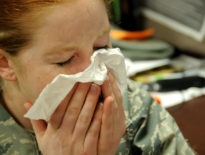
Photo credit: Public Health Image Library #8160, CDC / Dr. Terrence Tumpey / Cynthia Goldsmith
“Oh, a storm is threat’ning
My very life today
If I don’t get some shelter
Oh yeah, I’m gonna fade away”
Gimme Shelter by The Rolling Stones
By any measure, last year’s flu season (2017-2018) was very bad. The Centers for Disease Control and Prevention released a report last month estimating that influenza killed about 80,000 people in the US last season. That’s the highest number since 1976. How much worse is that than usual? Much worse. Previous years have caused between 12,000 and 56,000 deaths. 180 of those killed were children. Most of the children who died had not been vaccinated.
The last flu season also caused 900,000 hospitalizations.
People sometimes criticize the flu shot because it’s not always effective. They’re right. Last season’s vaccine was estimated to be 40% effective. That means people who were vaccinated were 60% as likely to require medical care from the flu as unvaccinated people. It’s not great. And the effectiveness varies from year to year. (And we’ll only know this year’s vaccine effectiveness after the season is over and the data is reviewed.) But vaccinated people also frequently get a milder illness than unvaccinated people. Imagine how many of those 900,000 hospitalizations could have been prevented if more people protected themselves.
People also sometimes criticize the flu shot because the protection is temporary. They’re right. The circulating strains change from season to season, and this season’s vaccine won’t help you next year. Vaccine manufacturers try, with varying success, to predict which strains will spread through North America and make each season’s vaccine based on that prediction.
So the protection isn’t perfect, and it doesn’t last long. Still, it’s the best we can do to prevent flu, along with frequent hand washing, covering coughs, and staying home when you’re sick. We use seat belts, we use umbrellas, and we build sukkot, because imperfect temporary shelter from risk is a lot better than no protection at all.
The CDC recommends that everyone over 6 months get a flu shot before the end of October. Maximal protection takes about two weeks after the vaccination.
Those at highest risk of serious complication from the flu are pregnant women, children, older adults, and those with chronic illnesses. If you’re not in one of those categories, getting the flu shot will still help prevent you from transmitting the flu to the more vulnerable people around you. So please get your flu shot this month. Our office has them. Your pharmacy has them.
A healthier winter for you, or for your neighbor who had a liver transplant, or for your pregnant coworker, or for your nephew, it’s just a shot away.
Learn more:
Flu broke records for deaths, illnesses in 2017-2018, new CDC numbers show (Washington Post)
Flu season deaths top 80,000 last year, CDC says (CNN)
Some of my previous posts about the flu shot:
Frequently Raised Objections To The Flu Shot
Sorting Out The Different Flu Vaccines

